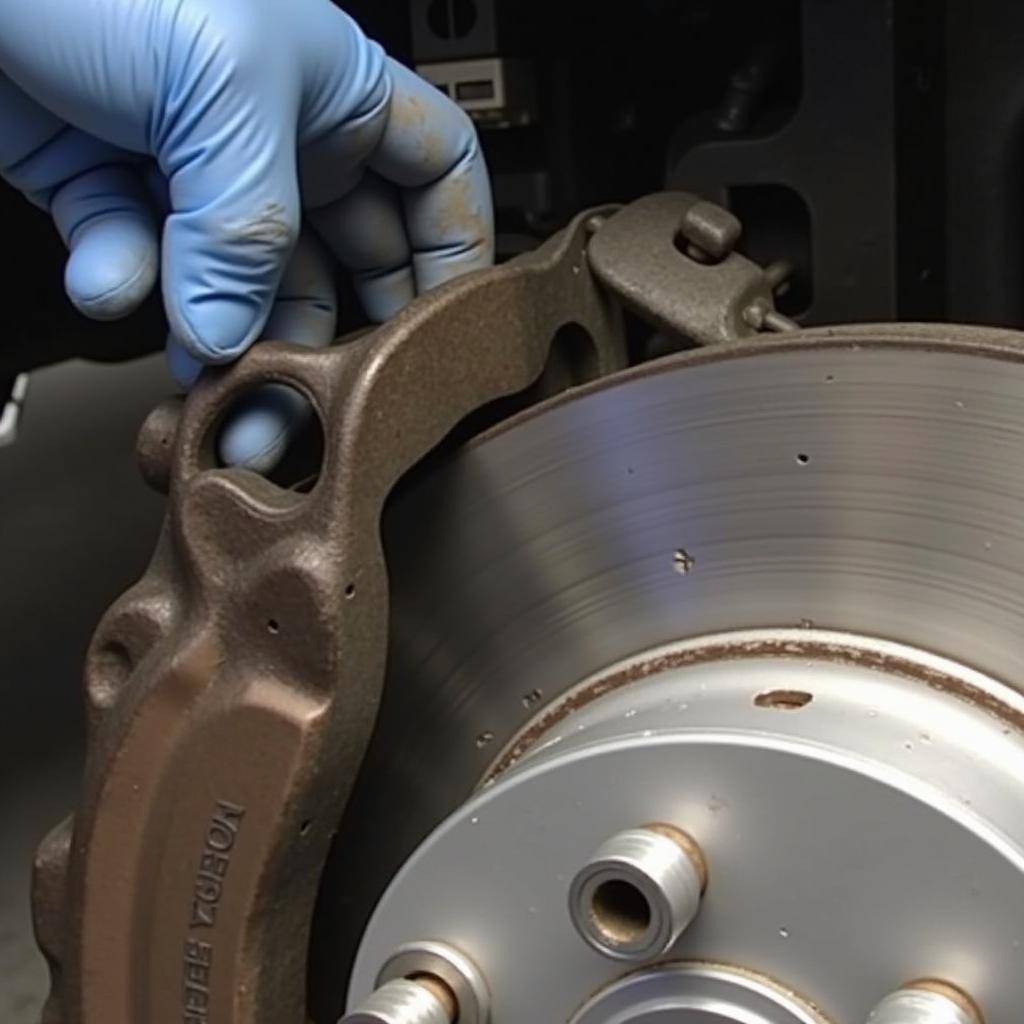The dreaded brake pad warning light. For an E60 BMW owner, it can be a source of anxiety, especially if you’re unfamiliar with the car’s intricate systems. Don’t fret, this article will guide you through understanding what triggers the E60 brake pad warning light, how to diagnose the issue, and what steps to take to get you back on the road safely.
Understanding Your E60’s Braking System
Before diving into the specifics of the warning light, it’s helpful to understand how your E60’s braking system functions. The E60 utilizes an advanced electronic braking system, which includes sensors that monitor the brake pads’ thickness. When the pads wear down to a predetermined level, these sensors trigger the warning light on your dashboard.
 E60 Brake Pad Sensor
E60 Brake Pad Sensor
What Triggers the E60 Brake Pad Warning Light?
The primary reason for the brake pad warning light illuminating is simple: your brake pads are wearing thin and need replacing. This is a normal part of wear and tear. However, there are other potential culprits, such as:
- Faulty brake pad wear sensor: Like any sensor, the brake pad wear sensor can malfunction due to damage, corrosion, or electrical issues.
- Worn brake rotor: A severely worn brake rotor can interfere with the brake pad wear sensor’s function, causing the light to illuminate prematurely.
- Wiring problems: Damaged or corroded wiring within the braking system can disrupt the signal from the sensor to the dashboard.
Diagnosing the Issue: A Step-by-Step Guide
“How can I tell what’s causing the brake pad warning light on my E60?” is a common question I get. Here’s a simplified approach to diagnosing the issue:
-
Visual Inspection: Begin by safely jacking up your E60 and removing the wheel on the side indicated by the warning light (if it indicates a specific side). Inspect the brake pad thickness through the wheel well. If you see less than 3mm of pad material, it’s time for new pads.
 Worn Brake Pads on E60
Worn Brake Pads on E60 -
Check the Sensor: If the brake pads appear to have sufficient material remaining, examine the brake pad wear sensor. Look for any visible damage to the sensor wire or its connection points.
-
Inspect the Rotor: While you have the wheel off, visually inspect the brake rotor for any deep grooves or uneven wear.
-
Seek Professional Help: If you’re unsure about your diagnosis or uncomfortable working with your car’s braking system, it’s always best to consult a qualified mechanic or BMW specialist.
Beyond DIY: Remote Software Solutions for E60 Brakes
“Can remote diagnostics and software solutions address brake issues in my E60?” Absolutely! In today’s technologically advanced world, remote diagnostics can play a crucial role in identifying and sometimes even resolving brake-related issues. For instance, if a faulty sensor is triggering the warning light prematurely, a software reset or recalibration might be possible remotely. However, it’s essential to understand that physical repairs like brake pad or rotor replacement still require hands-on intervention.
Addressing the E60 Brake Pad Warning: Next Steps
-
Replace Worn Parts: If your inspection reveals worn brake pads, rotors, or a damaged sensor, it’s crucial to replace these components promptly. Using high-quality parts specifically designed for your E60 is recommended.
-
Consider Professional Installation: While replacing brake pads can be a DIY project for experienced individuals, seeking professional installation from a qualified mechanic is advisable to ensure optimal braking performance and safety.
-
Don’t Ignore the Warning: Ignoring the brake pad warning light can lead to further damage to your E60’s braking system, compromising your safety and potentially resulting in more costly repairs down the line.
FAQs: Common Questions About E60 Brake Pad Warning Light
1. Can I still drive with the brake pad warning light on?
It’s not advisable. The light indicates your brake pads are nearing the end of their lifespan and driving with severely worn pads compromises braking efficiency and safety.
2. How much does it cost to replace brake pads on an E60?
The cost can vary depending on factors like labor rates and the chosen brand of brake pads. However, you can expect to pay between $200 to $500 for a typical brake pad replacement.
3. How often should I replace my E60’s brake pads?
Brake pad lifespan depends on driving style and conditions. As a general rule, it’s recommended to have your brake pads inspected every 10,000 miles and replace them as needed.
Conclusion
Addressing the E60 brake pad warning light promptly is crucial for maintaining your BMW’s braking performance and ensuring your safety on the road. By understanding the warning light’s meaning, diagnosing the issue, and taking the necessary steps for repair or replacement, you can enjoy peace of mind and continue experiencing the thrill of driving your E60.
Remember, your safety is paramount, and e60 brake pad warning shouldn’t be ignored. For any uncertainties, always consult a qualified mechanic or BMW specialist.
Need more help with a bmw brake warning light yellow? Don’t hesitate to seek professional advice.
